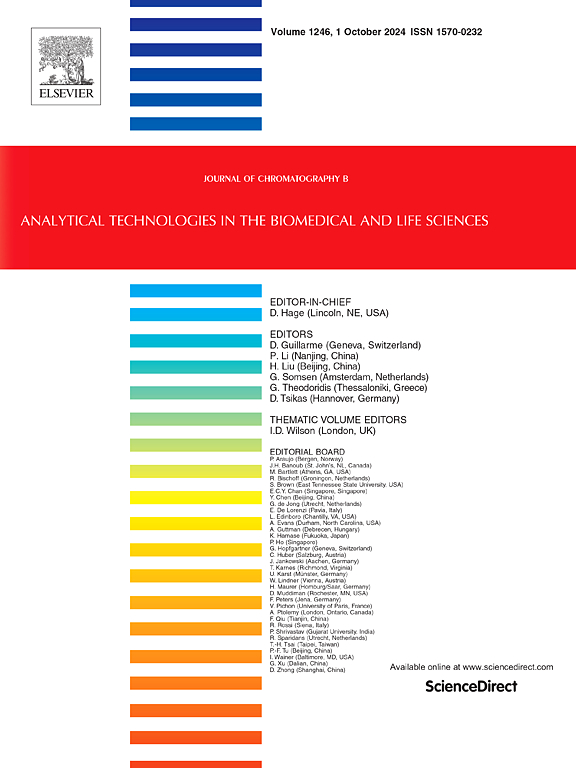A rapid and sensitive LC–MS/MS method for the simultaneous determination of chlorfenapyr and its major metabolite tralopyril in human plasma: From method development, validation to clinical application
IF 2.8
3区 医学
Q2 BIOCHEMICAL RESEARCH METHODS
引用次数: 0
Abstract
Chlorfenapyr (CFN), widely used as an insecticide, is a pro-insecticide that acts after being metabolized to the active metabolite tralopyril (TLP). In clinical practice, CFN poisoning is characterized by atypical symptoms, delayed toxicity and high mortality. The therapeutic importance of assessing TLP levels in the management of CFN poisoning has been demonstrated in recent clinical and toxicokinetic studies. Unfortunately, the simultaneous quantification of CFN and TLP poses technical challenges and is still lacking in clinical practice. In this study, a novel LC-MS/MS method was developed for rapid and accurate simultaneous analysis of CFN and TLP in human plasma within 3 min. Samples were extracted by acetonitrile protein precipitation. Stable CFN anionic adducts [M + HCOO]− were selected to provide satisfactory MS signals. To improve the signal and peak shape, the mobile phase was preferred to consisting of 2 mM ammonium formate containing 0.01 % ammonia and acetonitrile. The optimized multiple reaction monitoring transitions of m/z 451.0 → 346.9, 349.9 → 78.9 and 307.1 → 161.1 were selected in the negative ionization mode to detect CFN, TLP and IS (warfarin), respectively. The method demonstrated satisfactory linearity with low LLOQ (5 ng/mL for CFN and 1 ng/mL for TLP, respectively), and the precision and accuracy were acceptable. Both compounds showed good stability under relevant conditions. Furthermore, the method was successfully applied to 72 clinical plasma samples from 20 patients with CFN poisoning. The results showed that the concentration of TLP in plasma was significantly higher than that of CFN (P < 0.0001), and all five deaths demonstrated high TLP concentrations (>1000 ng/mL). These data demonstrate the potential relationship between toxins concentration and toxicity in CFN poisoning patients.
快速、灵敏的LC-MS /MS同时测定人血浆中氯非那韦及其主要代谢物曲洛吡里尔的方法:从方法开发、验证到临床应用
氯虫腈(Chlorfenapyr, CFN)是一种被广泛用作杀虫剂的前杀虫剂,经代谢为活性代谢物tralopyril (TLP)后起作用。在临床实践中,CFN中毒的特点是症状不典型,毒性延迟,死亡率高。最近的临床和毒性动力学研究证明了评估TLP水平在CFN中毒管理中的治疗重要性。不幸的是,同时量化CFN和TLP带来了技术挑战,在临床实践中仍然缺乏。本研究建立了一种新的LC-MS/MS方法,可在3 min内快速准确地同时分析人血浆中的CFN和TLP。选择稳定的CFN阴离子加合物[M + HCOO]−提供满意的质谱信号。为了改善信号和峰形,流动相优选为含有0.01%氨和乙腈的2 mM甲酸铵。在负电离模式下选择m/z 451.0→346.9、349.9→78.9和307.1→161.1的优化多反应监测跃迁分别检测CFN、TLP和IS(华法林)。该方法线性良好,低定量限(CFN为5 ng/mL, TLP为1 ng/mL),精密度和准确度均可接受。两种化合物在相关条件下均表现出良好的稳定性。该方法成功应用于20例CFN中毒患者的72份临床血浆样本。结果表明,血浆中TLP浓度显著高于CFN (P <;0.0001),所有5例死亡均显示高张力腿蛋白浓度(>1000 ng/mL)。这些数据证明了CFN中毒患者的毒素浓度与毒性之间的潜在关系。
本文章由计算机程序翻译,如有差异,请以英文原文为准。
求助全文
约1分钟内获得全文
求助全文
来源期刊

Journal of Chromatography B
医学-分析化学
CiteScore
5.60
自引率
3.30%
发文量
306
审稿时长
44 days
期刊介绍:
The Journal of Chromatography B publishes papers on developments in separation science relevant to biology and biomedical research including both fundamental advances and applications. Analytical techniques which may be considered include the various facets of chromatography, electrophoresis and related methods, affinity and immunoaffinity-based methodologies, hyphenated and other multi-dimensional techniques, and microanalytical approaches. The journal also considers articles reporting developments in sample preparation, detection techniques including mass spectrometry, and data handling and analysis.
Developments related to preparative separations for the isolation and purification of components of biological systems may be published, including chromatographic and electrophoretic methods, affinity separations, field flow fractionation and other preparative approaches.
Applications to the analysis of biological systems and samples will be considered when the analytical science contains a significant element of novelty, e.g. a new approach to the separation of a compound, novel combination of analytical techniques, or significantly improved analytical performance.
 求助内容:
求助内容: 应助结果提醒方式:
应助结果提醒方式:


